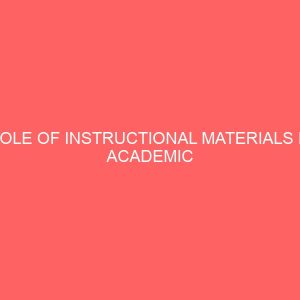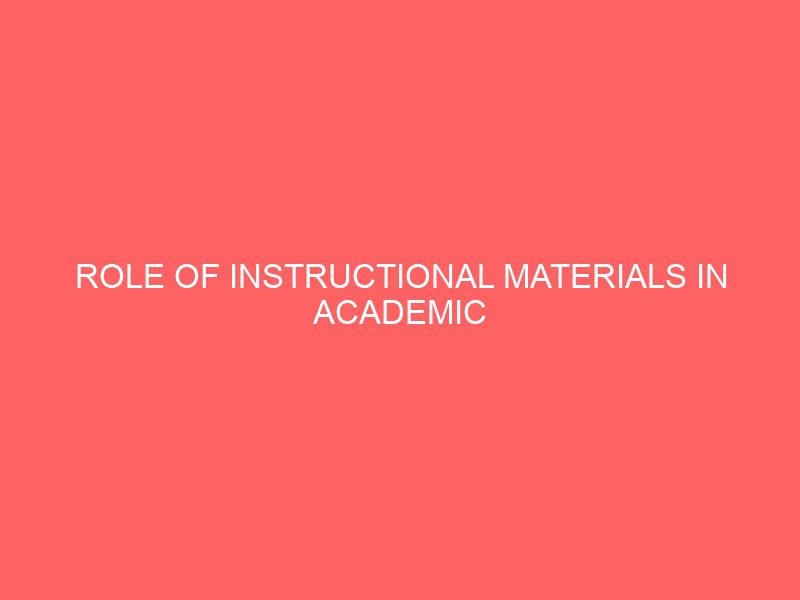Description
CHAPTER ONE
INTRODUCTION
1.1 Background Information
This research is on Role of instructional materials in academic performance in community secondary schools in Asokoro Abuja. Instructional materials have been observed as a powerful strategy to bring about effective teaching and learning. The importance of quality and adequate instructional materials in teaching and learning can occur through their effective utilization during classroom teaching. Instructional materials here include all the tools that the teachers can use to make the learning more interesting and memorable.
According to Farombi, (1998), instructional materials include books, audio-visual, software and hardware of educational technology. He further opines that the availability, adequacy and relevance of instructional materials in classrooms can influence quality teaching, which can have positive effect on students’ learning and academic performance. The insight from Farombi on linking instructional resources to students’ academic performance serve critical in the provision of quality education. The title of this thesis, role of instructional materials in academic performance in community secondary schools in ASOKORO Abuja originates from such ideas. Efficiency and high productivity in teaching and learning transaction. In my views, start from the access to quality and adequate instructional materials, and these should be prepared well before the class interaction.
According to Oni (1992), instructional resources are teachers’ strategic factor in organizing and providing education. This is so because they help to elaborate a concept that the teacher could not, without an instructional material. This allows students to learn more comfortably therefore influencing positively their academic performance.
Writing on the role of instructional materials in teaching and learning, Balogun (1982) commented that science education programmes cannot be taught effectively without the existence of equipment for teaching. This is because instructional materials help those who learn to develop problem-solving skills and scientific attitudes. Elaborating further on the same point, Ajayi and Ogunyemi (1990) emphasize that when instructional materials are provided to meet relative needs of teaching process, students will have access to the reference materials mentioned by the teacher, and also each student will be able to learn at his or her own pace. The overall result is that students will perform much better.
Before the coming of missionaries in Nigeria, traditional societies in Nigeria had their own means of providing education to the new generation, which was growing up. There was no for education however the young ones were taught through story telling, and also through tribal traditions. Under this system of education, the youth grew to become brave and skilled men and women; men became hunters, soldiers and craft workers, while women became good mothers and food gatherers and craft workers.
The beginning of formal education is traced to 1876 when the missionaries came to establish their mission stations. The first mission station was the Free Church of Scotland at Cape Maclear, and this group opened the Livingstonia Mission (Pachai, 1973). In the mid 1920s, government appeared on the education scene with more assistance and policy formulation. The department of education established in 1926 worked hand-in-hand with the missions, and more schools were introduced.
Community secondary school program in Nigeria started in 1970s when the government decided to take over all private secondary schools for the aim of ensuring that all the children had an equal chance of getting education. Further development of community secondary schools in Nigeria took place in 1980s and 1990s; during this era some major changes took place in the history of community secondary education in Nigeria. The first major change was the re-introduction of community secondary schools as a response to the unforeseen increase requirement for secondary education. This demand came into being following the implementation of Universal Primary Education (UPE) (URT, 1995).
The implementation of UPE created unparalleled social demand for secondary education. The increase in the enrolment in primary schools resulted in the expansion of Secondary education through a strategy of constructing community secondary schools in each ward in Nigeria. A circular was issued by the government in 1984 to initiate a ten-year programme for the expansion of secondary education. The programme was not implemented until in 1986 when it started and was to be completed by 1995 with the construction of 79 secondary schools which were to be distributed in such a way that each region was to build three schools. Essentially, community secondary schools are government schools in which both local communities and the central government have the responsibility to run the schools (URT, 1995).
The government through Ministry of Education and Vocational Training (MoEVT), with the help of foreign donors, members of the community, development partners, contributions from local government, government through internal and external sources took the initiative to start building community secondary schools all over the country in each ward as pointed earlier. To the large extent, community secondary schools supported by government, community contributions, development partners and local government contributions have provided education to children from poor families, who are mostly found in rural remote areas, while government provided schools with financial and technical support such as paying teachers’ salaries.
Secondary school education in Nigeria refers to that full time program of education provided in accordance with Government approved curricula and availed to students who have completed primary education (URT, 1995). According to the Education Policy of 1995, this level of education consists of two sequential phases; ordinary level secondary education which last for four years and a two-year of advanced level secondary education (URT, 1995). The standards that the Ministry of Education and Vocational Training (MoEVT) has stipulated, selection of students to be enrolled into community secondary schools are made on the ‘basis of a pre-set national standard cut-off point of performance’ in the National Primary School Leaving Examination (PSLE) (URT, 1995). Students enrolled in community secondary schools need to have a minimum of 100 scores in their Primary School Leaving Examination (PSLE).
On the other hand, selection and enrollment into community secondary schools is the same as that which is done in other secondary schools. The selection is done after students’ attainment of appropriate credits in the final secondary examination. In all cycles the emphasis has been on development in terms of access and improved quality of teaching and learning (URT, 2004).
Instructional materials are considered important in teaching and learning in all levels of education because textbooks and other resource materials are basic tools. Absence or inadequacy makes teachers handle subjects in an abstract manner, portraying it as dry and non-exciting (Eshiwani, 1984). For example, textbooks, charts, maps, audiovisual and electronic instructional materials such as radio, tape recorder, television and video tape recorder contribute much in making learning more interesting (Atkinson, 2000). The importance of instructional materials is also evident in the performance of students (Adeogun, 2001).
According to Adeogun, schools, whose teachers use more instructional resources perform better than schools, whose teachers do not use instructional materials. This corroborated the study by Babayomi (1999) that private schools performed better than public schools because students and teachers are provided with sufficient and quality teaching and learning resources. From this importance, schools at all levels of education have been advised to have quality and adequate instructional facilities to raise academic performance of their students.
The advice emanated from the fact that instructional facilities have a potent factor to qualitative education. The dictum is that “teaching is inseparable from learning but learning is separable from teaching.” This means that teachers do the teaching to make the students learn, but with quality and adequate instructional facilities, students can learn without the teachers. According to Akande (1985), learning can occur through one’s interaction with one’s environment. Environment here refers to instructional facilities that are available to facilitate students learning outcome.
Instructional materials such as the size of classroom, sitting position and arrangement, availability of tables, chairs, chalkboards, shelves on which instruments for practical’s, are important in the teaching transaction (Farrant, 1980 and Farombi, 1998). According to these scholars, availability of instructional materials can work best if other conditions are met such as the quality of classroom. I would add, the quality of teachers to use these resources. While acknowledging the importance of instructional materials, there is little agreement on their roles on academic performance and this difference in understanding, is the focus of this study.
Studies have been conducted mainly focusing on pedagogical and curriculum trends. However, studies on the role of instructional materials in academic performance for a country like Nigeria are highly needed due to the importance discussed above and the challenges facing the education system. Academic performance according to the Cambridge University Reporter (2003) is frequently defined in terms of examination performance. Academic performance is normally measured by the examination results because this is one of the major goals of a school. Hoyle (1986) reiterated that schools are built in order to provide knowledge and skills to those who go through them and behind all this is the idea of enhancing good academic performance. In this study, academic performance was characterized by performance in classroom tests, in course work and performance in the final examinations.
In this study, I explored conceptions from teachers’ on understanding of the importance of instructional materials in improving teaching and learning in secondary school education in Nigeria. In conducting this study, I have been interested in a reciprocal availability of instructional facilities, where the number of schools and enrollments are increasing while instructional materials are inadequate or in sorry state (see MoEVT, 2010). This reciprocal relationship is creating inefficiency gap between the governmental intentions stipulated in the Secondary Education Development Program (SEDP) and the realities existing in community secondary schools. The gap has led to the emerging criticism that community secondary schools are not effective, as a large number of students do not acquire required skills and hence perform poorly in their final examinations.
A research carried out by Sumra and Rajani (2006) indicated that a number of learners finish secondary education without acquiring essential skills that are needed in life. This shows that increase in number of students has been prioritized over the number and quality of instructional materials (Hakielimu, 2007; Makombe et al, 2010). Some studies have specifically shown that teaching in community secondary schools is poor as these schools lack necessary teaching facilities such as furniture for staff and students, books, science equipment, games and sport equipment (Benell and Mukyanuzi, 2005).
Moreover, teachers lack essential skills to make quality teaching and learning aids. According to a National Audit report, some schools are completely lacking material resources such as textbooks, charts, maps, audio-visual and electronic instructional materials such as radio, tape recorder, television and video tape recorder.
From these facts on the ground, efforts to improve the quality of provision of education in community secondary schools in Nigeria have appeared to slow down, as some of these challenges were not prioritized in the SEDP 2004 – 2009 (Sumra and Rajani, 2006). More studies are needed in Nigeria to expose this situation. If the country aims at producing a competitive economy to meet global market demands, as stipulated in the vision of the Ministry of Education, Science and Technology (MoEVT, 2010), availability of quality and adequate instructional facilities in community secondary schools should be given a high priority. In this study strategy for making quality instructional materials available are suggested as an attempt to narrow efficiency gap in the provision of education in community secondary schools in Nigeria.
Inadequacy of quality instructional materials is not confined to Nigeria, as this is a worldwide phenomenon. Even in developed countries for example, United States of America especially in schools whose majority of population are the poor and minority students are less funded and lack essential quality instructional materials. In addition, policies associated with school funding, resource allocations, and tracking leave minority students with fewer and lower-quality books, curriculum materials, laboratories, and computers (Post and Darling, 2000).
A study conducted in the Abuja of Columbia school system found, after controlling for other variables such as a student’s socioeconomic status, that students’ examination results were lower in schools with poor building conditions. Students in school buildings in poor condition performed badly, that is, 6% below schools in fair condition and 11% below schools in excellent condition (Edwards, 1991). The situation is more critical in less developed countries. For instance, studies done by Carron and Chau, (1996) in India, and Willms (2000) in Latin America indicated acute shortage of school facilities such as classroom materials and inadequate library which led to poor academic performance in the areas most affected by this problem in these countries. A survey which was conducted by UNICEF/UNESCO in 1995 in 14 least developed countries showed that the size of classes ranged from fewer than 30 students in rural and urban Bhutan, Madagascar, and the Maldives, to 73 in rural Nepal and 118 in Equatorial Guinea (Postlewaithe, 1998).
In most African countries there is an endemic lack of adequate instructional materials most especially in rural areas. A research done by Gogo (2002) on the input of cost sharing on access, equity and quality of secondary education in Rachuonyo Abuja in Kenya indicated that the quality of education had not changed much for a number of years due to inadequate teaching and learning materials and equipment. Further, studies done in other parts of Africa reveal the same problem.
For example in Nigeria Farombi (1998) did a study on resource concentration, utilization and management as correlates with students learning outcomes in Oyo State. He discovered that instructional facilities in some schools were very poor. He cited examples of schools without chalkboard, absence of ceiling, some roofing sheets not in place, windows and doors removed among others, a situation which the researcher regarded as hazardous to healthy living for the learners. Another study done by FEMSA on the availability of teaching and learning resources for mathematics and science in four African countries, Cameroon, Ghana, Nigeria and Uganda revealed that there was critical shortage of instructional facilities mostly for teaching science and mathematics.
1.2 Statement of the problem
Most studies that look into the state of instructional resources in schools, rarely do scholars attach poor performance with lack of, or inadequacy of these materials. As the studies above indicate instructional materials are important in teaching and learning and are inadequate in many schools (Kerr, 2003). Although studies in
Nigeria (see for example those of Sumra and Rajani, 2006; Hakielimu, 2007; Makombe et al, 2010) have lamented on poor performance, they did not link this situation with inadequate quality instructional resources. These studies are clear that there is a strong link between adequate and quality instructional materials and quality teaching and learning process (Blair, 1998) but have not shown this link with students’ academic performance. Other studies conducted by researchers such as Earthman and Lemasters (1996) have shown that learners who are provided with safe, modern and environmentally controlled situation learn much better and their academic performance are high.
School finance trends in Nigeria have shown a notable decrease in funding for educational facilities (MoEVT, 2014). However, studies are needed to draw a clear comparison between the quality of instructional materials in community secondary schools and academic outcomes. In order for the government to support educational reform that will boost student performance, they will need to understand the level of relationship between instructional materials and academic performance.
1.3 Objectives
1.3.1 General Objective
The general objective of this study was to examine the extent to which the selected community secondary schools in ASOKORO Abuja utilize quality and adequate instructional materials in classrooms and how this has promoted academic performance of students. The findings of this study have implications for policy and practice regarding the planning and funding of schools for quality provision of education.
1.3.2 Specific Objectives
The study was guided by the following research objectives:
- To explore the views of teachers and students on the extent to which
instructional facilities affect student performance.
- To examine the challenges that teachers in community secondary schools face in accessing instructional materials.
- Assess the strategies that teachers use to minimize the challenges of attaining and using quality instructional materials.
The study was guided by the following research questions:
- What are the views of teachers and students on the extent to which instructional materials affect students’ performance?
- What are the challenges that teachers in community secondary schools face in accessing instructional materials?
- What are the strategies that teachers use to minimize the challenges of attaining and using quality instructional materials?
1.3.3 Scope of the Study
This study dealt with conditions of community secondary schools in relation to students’ behavior and performance. The focus of the study was on the availability and utilization of instructional materials. The study focused on selected community secondary schools around ASOKORO Abuja. The context of this research is unique to ASOKORO Abuja and therefore it cannot be generalized for the whole country.
1.3.4 Significance of the Study
This study intended to find the impact of inadequate instructional materials in community secondary schools in ASOKORO Abuja. The knowledge obtained would help the government most especially local government and educators to reflect and make evaluation on the requirements of other instructional materials apart from class-rooms alone. Since the beginning of community secondary schools, the government and local communities have been putting more emphasis on the construction of new class-rooms, and recently, construction of laboratories. However, provision of quality secondary school education requires more than just class-rooms and laboratory buildings. The evaluation of instructional materials, along with other reform movements, allows educators and planners to plan for appropriate environment for teaching and learning so as to provide quality secondary school education.
The study would also influence education planners to consider appearances of physical structures such as classrooms and availability of other teaching and learning materials as some of the important factors that can influence parents to send their children to particular schools, which have attractive physical appearance and variety of other facilities. Attractive environment and the availability of other learning resources can influence students to stay in schools and stimulate learning. This study would be helpful for fulfilments of the requirement of Masters of Education degree in Administration, Planning and Policy studies.
Also the knowledge acquired from this study would be very important to other researchers who have interest in demographic dynamics of school age going children in relation to planning of school facilities. If the study concludes that students in community secondary schools perform poorly due to the lack of sufficient instructional materials, this knowledge will enable education planners to re-think the range of services the government and local communities can provide to school-aged children, and the wider community, and to find creative ways of improving school facilities that would otherwise be ineffectively utilized due to funding pressures.
1.3.5 Operational Definition of Key Terms
Instruction materials are facilities given to students, so that they can use every opportunity to develop full potential. Instructional materials include fixtures, equipment, and buildings necessary for the effective and efficient operation of the program of public education (uslegal.com, 2015).
Academic performance refers to the level at which a student, teacher or institution has managed to reach their educational goals.
Community refers to a group of people with common socio-economic and cultural characteristics or interests, legally and administratively recognized to designate a village or a ward. Thus, school community is defined as the catchments areas of the school, that is, the area from which all or most of the students are drawn and where the families and neighbors of the students reside, who assist financially or otherwise with the establishment, maintenance and continuing operation of the school.
Community secondary schools are secondary schools owned by local community or owned by an institution on behalf of a community (URT 1995).
1.3.6 Chapter Summary
The analysis of the availability of instructional materials which this study did is very important due to its impact on the students’ and teachers’ achievement, behavior and attitudes towards continuing learning and teaching. It is illogical to expect good results from programs that have to take place in environments, which are not conducive. Based on the general objective and research questions, the state of instructional materials in community secondary schools in ASOKORO Abuja and their impact on learning and teaching processes was revealed.








Reviews
There are no reviews yet.